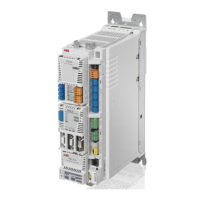9
Common DC configurations
Introduction
ACSM1 drive modules can be connected via DC terminals together to have so
called common DC configuration. Within common DC the drives with
regenerative power from motor can feed via DC link the other drives, which are
on motoring mode. Major benefits with this kind of connection are the following:
• Energy saving due to reduced need for the supply side power. In
optimum case there is also no need for braking resistors, if
simultaneous regenerative power is not higher than motoring power.
• DC link energy storage can be used for short dynamic braking energy
pulses to avoid need for external braking resistor.
• Braking energy can be handled with one unit even if several drives are
at the same time in regenerative mode. However, several units with
active braking chopper can be used simultaneously with braking
resistor if needed.
• Possibility for one AC input connection. The selected unit is,
additionally to its own axis power, feeding also other drives connected
to common DC.

